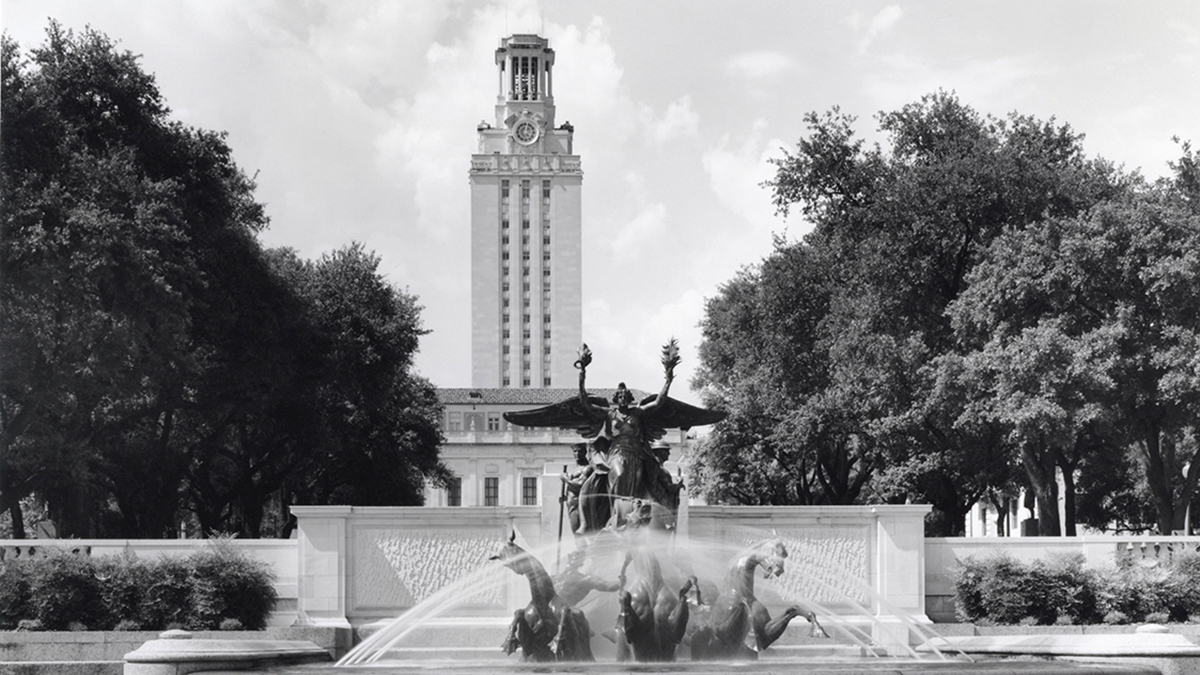It's everywhere. Set foot on the University of Texas campus, and you'll find it in the front covers of library books, on the shoulder patches of UT police officers, inlaid on the floor in Gregory Gym, on brass plaques that recognize University donors, and in limestone ornaments adorning UT buildings. It's printed on University degrees, official stationery, and nametags. It's the University of Texas seal, now more than a century old.
Modern universities made their first appearance in 12th century Europe, as a highly evolved academic guild of masters and students (the Latin word "universitas" was the medieval legal term used to identify an autonomous union or organization). From the beginning, academic insignia and dress became an integral part of university culture. Congregations, installations, lectures, examinations, and inceptions (graduations) all observed ritual words, objects, music, and required forms of dress. A scepter or mace carried by the rector identified him as the head of a university, newly nominated doctors often received gold rings with their degrees, and hooded capes, known a "cappa clausa," were worn to identify university members to the public, with special colors and designs for both students and teachers.
The most prized symbol of a university was its seal. Granted by a pope or monarch, the seal officially recognized a university as a corporation that could conduct legal affairs, and whose members had special rights and privileges different from ordinary townsfolk. Often the original carving of the seal was kept in a special chest with a triple lock, and several university authorities were required to be present to open it.
Early university seals were usually intricate, elaborate designs: a student at a desk reading a book, the rector in academic garb holding a mace, or an image of a saint special to the university. A Latin inscription, the "motto" of the university, was almost always included, and was sometimes considered the most important part of the design. Later, as knights were permitted to have seals that resembled their personal shields, university seals began to sport coats of arms of their own.
In November 1881, the Board of Regents of the University of Texas convened in Austin for its inaugural meeting. Among the many items on the agenda, a sub-committee of the board was asked to design a seal for the new university. They completed their task in a single afternoon.
The original UT seal borrowed liberally from the seal of the State of Texas, with a five pointed star framed on the left by an oak branch, representing strength, and on the right by an olive branch, signifying peace. Placed within a circle, "Universitas Texana" labeled the seal as belonging to the University, with the motto "Non Sine Pulvera Palma. A well-known Latin phrase, the motto may be translated as "The prize cannot be won without effort," or in more modern terms, "Do your best."
Money was set aside to purchase an embossing stamp, but the University seal wasn't very popular. It was seen only rarely, limited to decorating degrees and a few other official documents.
In 1901, Dr. William Battle, a well-known and popular professor of Greek on the Forty Acres, took it upon himself to design a new, more distinctive seal for the University. He may have been prompted by the regents' decision in 1900 to recognize orange and white as UT's official colors, and thought the time was right. Of the original seal, Battle thought, "Except for the word Universitas, it might just as well have been the emblem of the State Penitentiary."
In his usual thorough way, Battle purchased books on heraldry, sent for and received copies of seals from universities across the U.S. as well as from Oxford and Cambridge in England. At his own expense, Battle hired a leading firm in heraldic design – the Bailey, Banks and Biddle Company of Philadelphia – as consultants and to sketch prototypes according to his directions.
The process went through several versions, all of which are still preserved in the UT archives in the Center for American History. Battle himself changed the motto to Republic of Texas President Mirabeau B. Lamar's famous quote, "A cultivated mind is the guardian genius of democracy," which at the time regularly appeared on the inside covers of most University publications. Battle's Latin translation of Lamar was "Mens Instructa Civitatis Custos," but this sounded a bit clunky. Instead, Battle conferred with friend and colleague Dr. Edwin Fay, head of UT's Latin Department, who suggested, "Disciplina Praesidium Civitatis."
In its final version, Battle described the University seal:
"In conformity with general usage, the design adopts as its central feature the shield form that shows the origin of its heraldic arms. The shield is divided into two fields, the upper white, the lower orange, the University colors. In the lower and larger field are the historic wreath and star of the Great Seal of the State of Texas; in the upper field is an open book, fit symbol of an institution of learning. The shield rests within a circle of blue, the color of sincerity, containing the motto, "Disciplina Praesidium Civitatis." This is Professor Edwin W. Fay's rendering of the apothegm of President Mirabeau B. Lamar, "Cultivated mind is the guardian genius of democracy. Around the disk of blue is a larger disc of red, color of strength, bearing the words, 'Sigillum Universitatis Texanae.'"
Battle presented his seal to UT President William Prather in 1903. Two years later, on October 31, 1905, the Board of Regents officially approved Battle's proposal, though the words, "Sigillum Universitatis Texanae," were changed to the English, "Seal of the University of Texas." Within a year, the new seal appeared on library bookplates, invitations and programs of University events, and, of course, diplomas.
